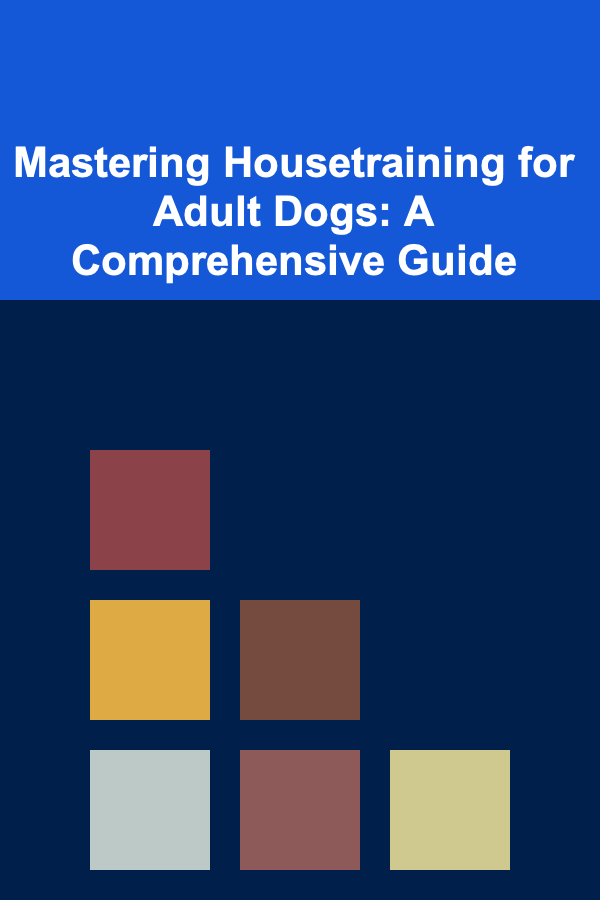
Mastering Housetraining for Adult Dogs: A Comprehensive Guide
ebook include PDF & Audio bundle (Micro Guide)
$12.99$9.99
Limited Time Offer! Order within the next:

Housetraining is a fundamental aspect of dog ownership, and while often associated with puppies, adult dogs can also require housetraining or retraining. Whether you've adopted an older dog from a shelter, rescue, or simply have a dog who has developed inappropriate elimination habits, understanding the process and implementing the right strategies is crucial for success. This comprehensive guide delves deep into the nuances of housetraining adult dogs, providing insights, techniques, and troubleshooting advice to help you and your canine companion achieve a harmonious and accident-free life together.
Understanding the Challenges of Housetraining Adult Dogs
Housetraining an adult dog presents unique challenges compared to puppies. These challenges often stem from pre-existing habits, underlying medical conditions, or behavioral issues. Recognizing these potential hurdles is the first step towards developing an effective training plan.
Pre-Existing Habits and Learned Behaviors
Unlike puppies who are a blank slate, adult dogs may have already developed established elimination patterns. These patterns might be inappropriate for your home environment and can be difficult to break. For instance, a dog who lived outdoors may not be accustomed to holding their bladder or bowels for extended periods. Similarly, a dog who was previously allowed to eliminate indoors due to neglect or medical issues may need to unlearn these ingrained behaviors.
Medical Considerations
Inappropriate elimination can sometimes be a symptom of underlying medical conditions. Before embarking on any housetraining program, it's crucial to rule out any potential health problems. Common medical conditions that can affect urination and defecation in dogs include:
- Urinary Tract Infections (UTIs): UTIs can cause frequent urination, urgency, and discomfort, leading to accidents.
- Diabetes: Increased thirst and urination are common signs of diabetes.
- Kidney Disease: Kidney problems can affect the dog's ability to concentrate urine, leading to increased urination.
- Cushing's Disease: This hormonal disorder can cause increased thirst and urination.
- Incontinence: Incontinence, especially in older female dogs, can result from weakened bladder muscles.
- Arthritis or Mobility Issues: Pain or difficulty moving can make it challenging for the dog to reach the designated potty spot in time.
- Parasites: Certain parasites can cause digestive upset and diarrhea, leading to accidents.
A thorough veterinary examination, including blood and urine tests, can help identify and address any underlying medical conditions that may be contributing to the problem. Once any medical issues are resolved, housetraining efforts will be more effective.
Behavioral Issues and Anxiety
Anxiety, fear, and stress can also trigger inappropriate elimination in adult dogs. Separation anxiety, fear of loud noises, or changes in the environment can all contribute to accidents. In some cases, the dog may be marking territory due to anxiety or insecurity. Identifying and addressing the underlying cause of the anxiety is crucial for resolving the housetraining issue. Consider consulting with a veterinary behaviorist or certified professional dog trainer to help manage anxiety and develop appropriate coping mechanisms.
Lack of Consistent Routine and Supervision
Adult dogs, just like puppies, thrive on routine and consistency. A lack of a predictable schedule for feeding, walks, and potty breaks can lead to confusion and accidents. Inadequate supervision can also allow the dog opportunities to eliminate indoors without being corrected or redirected. Providing a structured environment with clear expectations is essential for successful housetraining.
Establishing a Foundation for Success: Preparation and Planning
Before you begin the housetraining process, it's important to lay a solid foundation by preparing your home, establishing a routine, and gathering the necessary supplies.
Home Preparation and Cleaning
Thoroughly clean any areas where your dog has previously eliminated indoors using an enzymatic cleaner specifically designed for pet messes. These cleaners break down the organic components of urine and feces, eliminating odors that can attract the dog back to the same spot. Avoid using ammonia-based cleaners, as ammonia is a component of urine and can actually encourage the dog to repeat the behavior. It is also important to make these areas less accessible if possible through the use of baby gates or by restricting access when you cannot supervise.
Creating a Consistent Routine
Establish a predictable daily routine for your dog, including:
- Feeding Schedule: Feed your dog at the same times each day. This helps regulate their digestive system and makes it easier to predict when they need to eliminate.
- Potty Breaks: Take your dog outside to their designated potty spot first thing in the morning, after meals, after naps, after playtime, and before bedtime. The more frequent, the better.
- Walks and Exercise: Regular walks and exercise help stimulate bowel movements and provide mental stimulation, reducing anxiety and boredom.
- Playtime and Training: Incorporate playtime and training sessions into your daily routine to strengthen your bond with your dog and provide mental enrichment.
Gathering Essential Supplies
Having the right supplies on hand can make the housetraining process smoother and more efficient. Essential supplies include:
- Enzymatic Cleaner: For cleaning up accidents and eliminating odors.
- Leash and Collar: For taking your dog outside to their potty spot.
- High-Value Treats: For rewarding your dog when they eliminate in the correct place. Choose treats that your dog finds irresistible.
- Potty Training Bells (Optional): To teach your dog to signal when they need to go outside.
- Crate (Optional): For crate training, which can be a helpful tool for housetraining.
- Pet Stain and Odor Remover: For cleaning carpets and upholstery.
Implementing the Housetraining Plan: Techniques and Strategies
With your home prepared and your routine established, you can now begin implementing your housetraining plan. The following techniques and strategies will help you guide your dog towards appropriate elimination habits.
Crate Training (Optional but Highly Recommended)
Crate training can be a valuable tool for housetraining adult dogs. Dogs naturally avoid soiling their sleeping area, so a crate can help them develop bladder and bowel control. If you choose to crate train, introduce the crate gradually and make it a positive experience for your dog. Never use the crate as punishment.
- Introduction: Make the crate inviting by placing comfortable bedding and toys inside. Encourage your dog to enter the crate voluntarily by tossing treats inside.
- Gradual Acclimation: Start with short periods of time in the crate, gradually increasing the duration as your dog becomes more comfortable.
- Feeding in the Crate: Feed your dog their meals in the crate to create a positive association.
- Potty Breaks: Take your dog outside immediately after they come out of the crate.
- Crate Size: The crate should be just large enough for your dog to stand up, turn around, and lie down comfortably. Too large of a crate defeats the purpose of avoiding soiling their sleeping area.
Establishing a Designated Potty Spot
Choose a specific area in your yard where you want your dog to eliminate. Take your dog to this spot on a leash every time you go outside for a potty break. Using the same spot consistently will help your dog associate that area with elimination. You can even use a specific command, like "Go potty" or "Do your business" to associate the action with the location.
Consistent Potty Breaks
Take your dog outside frequently, especially at key times:
- First thing in the morning
- After meals
- After naps
- After playtime
- Before bedtime
If you are unsure how often your dog needs to go, start with every two hours and adjust as needed. Pay close attention to your dog's body language. Signs that your dog needs to eliminate include circling, sniffing the ground, squatting, and pacing. If you see these signs, take your dog outside immediately.
Positive Reinforcement
When your dog eliminates in the designated potty spot, praise them enthusiastically and immediately reward them with a high-value treat. Use a specific praise word, such as "Good potty!" or "Yes!" to mark the desired behavior. The immediacy of the reward is crucial; ideally, the treat should be given within a few seconds of the dog finishing eliminating. This positive reinforcement will strengthen the association between eliminating in the correct place and receiving a reward, making them more likely to repeat the behavior in the future.
Supervision and Prevention
When you are not actively training or taking your dog outside for potty breaks, supervise them closely. Keep them on a leash indoors or confine them to a small, easily monitored area, such as a crate or a room with baby gates. This will prevent them from having accidents unnoticed and allow you to intervene if you see any signs that they need to eliminate.
Interrupting Accidents and Redirecting
If you catch your dog in the act of eliminating indoors, interrupt them immediately with a firm but not angry "No!" or "Uh-oh!". Do not yell or punish your dog, as this can create fear and anxiety, making them less likely to eliminate in front of you in the future. Instead, immediately take them outside to their designated potty spot. If they finish eliminating outside, praise and reward them. If they do not, bring them back inside and continue to supervise them closely. The key is to interrupt the inappropriate behavior and redirect them to the appropriate location.
Potty Training Bells (Optional)
Teaching your dog to ring a bell when they need to go outside can be a helpful way to communicate their needs. Hang a set of bells near the door you use for potty breaks. Each time you take your dog outside, gently touch the bells with their nose or paw and say a cue word like "Potty" or "Outside." When your dog eliminates outside, praise and reward them. Over time, they will learn to associate ringing the bells with going outside to eliminate. Start by associating the bell ringing with a treat initially. Then, gradually require them to ring the bell themselves before you take them out.
Addressing Marking Behavior
If your dog is marking indoors, it's important to address the underlying cause. Marking is often triggered by anxiety, insecurity, or the presence of other animals. Consider the following strategies:
- Neutering/Spaying: Neutering or spaying can significantly reduce marking behavior, especially in male dogs.
- Reduce Anxiety: Identify and address any sources of anxiety in your dog's environment. Consider using calming aids like pheromone diffusers or anxiety wraps.
- Clean Thoroughly: Clean marking spots thoroughly with an enzymatic cleaner to eliminate odors.
- Supervision: Supervise your dog closely and interrupt any marking attempts.
- Training: Teach your dog a "leave it" or "no" command to interrupt marking behavior.
- Veterinary Behaviorist: In severe cases, consult with a veterinary behaviorist for guidance on managing marking behavior.
Troubleshooting Common Housetraining Problems
Even with a well-structured housetraining plan, you may encounter setbacks and challenges. Here are some common problems and how to address them:
Regression: Sudden Accidents After Progress
If your dog has been consistently eliminating outside but suddenly starts having accidents indoors, it could be a sign of a medical problem, increased stress, or a change in routine. Rule out medical issues first by consulting with your veterinarian. If there are no underlying health problems, consider any recent changes in your dog's environment or routine that might be causing stress. Revisit the basics of housetraining and increase supervision. Ensure you are cleaning any accidents with enzymatic cleaner to eliminate any residual odor that could be attracting the dog back to that spot.
Resistance to Going Outside
Some dogs may resist going outside, especially in inclement weather. Make the experience more positive by providing a comfortable raincoat or sweater, clearing a path in the snow, and offering extra praise and rewards for eliminating outside. You can also try making potty breaks shorter in bad weather and taking them out more frequently.
Eating Feces (Coprophagy)
Coprophagy, or eating feces, can be a frustrating and unpleasant behavior. The reasons for coprophagy are complex and not fully understood, but potential causes include dietary deficiencies, boredom, anxiety, and learned behavior. Consult with your veterinarian to rule out any medical or dietary issues. Ensure your dog is receiving a balanced diet and consider adding digestive enzymes or probiotics to their food. Supervise your dog closely during potty breaks and immediately pick up any feces to prevent them from eating it. You can also try using a product designed to make feces taste unpleasant.
Inconsistent Elimination: Urinating Frequently in Small Amounts
Frequent urination in small amounts can be a sign of a urinary tract infection, bladder stones, or other medical conditions. It can also be caused by anxiety or territorial marking. Consult with your veterinarian to rule out any medical issues. If anxiety is a factor, consider using calming aids or consulting with a veterinary behaviorist. Ensure you are cleaning accident areas thoroughly with enzymatic cleaner.
Diarrhea and Accidents
Diarrhea can make it difficult for your dog to control their bowels, leading to accidents. If your dog has diarrhea, consult with your veterinarian to determine the cause. Provide plenty of fresh water and consider feeding them a bland diet, such as boiled chicken and rice, until the diarrhea subsides. Take them outside more frequently for potty breaks and clean up any accidents thoroughly. If the diarrhea persists for more than 24 hours, seek veterinary attention.
Patience, Consistency, and Positive Reinforcement: The Keys to Success
Housetraining an adult dog requires patience, consistency, and positive reinforcement. Remember that every dog learns at their own pace, and setbacks are normal. Don't get discouraged if your dog has accidents. Instead, stay positive, consistent, and persistent with your training efforts. Focus on rewarding desired behaviors and preventing accidents. By establishing a structured routine, providing consistent supervision, and using positive reinforcement techniques, you can help your adult dog learn to eliminate appropriately and enjoy a happy and accident-free life together.
It is important to remember that consulting with a certified professional dog trainer or a veterinary behaviorist can provide personalized guidance and support throughout the housetraining process. They can help you address specific challenges and develop a customized training plan tailored to your dog's individual needs and personality.

Becoming a Successful Account Manager: Proven Techniques for Effective Client Solutions
Read More
How to Declutter Your Kitchen and Free Up Counter Space
Read More
How to Host a Fun Scavenger Hunt for Your Family
Read More
How to Make a Team Building Activities Checklist for High-Energy Teams
Read More
How to Soundproof Your Doors and Windows
Read More
The Future of Passive Income in Deep Learning and AI
Read MoreOther Products

Becoming a Successful Account Manager: Proven Techniques for Effective Client Solutions
Read More
How to Declutter Your Kitchen and Free Up Counter Space
Read More
How to Host a Fun Scavenger Hunt for Your Family
Read More
How to Make a Team Building Activities Checklist for High-Energy Teams
Read More
How to Soundproof Your Doors and Windows
Read More